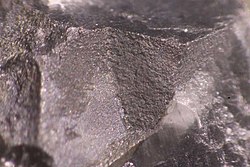| Crookesite | |
|---|---|
 | |
| General | |
| Category | Selenide mineral |
| Formula | Cu 7(Tl, Ag)Se 4 |
| IMA symbol | Crk [1] |
| Strunz classification | 2.BD.50 |
| Crystal system | Tetragonal |
| Crystal class | Disphenoidal (4) H-M symbol: (4) |
| Space group | I4 |
| Identification | |
| Color | Lead-gray |
| Crystal habit | As finely divided, disseminated specks, and as small veinlets. |
| Cleavage | Good, two at right angles |
| Fracture | Brittle |
| Mohs scale hardness | 2.5–3 |
| Luster | Metallic |
| Diaphaneity | Opaque |
| Specific gravity | 6.90 |
| References | [2] [3] |
Crookesite is a selenide mineral composed of copper and selenium with variable thallium and silver.